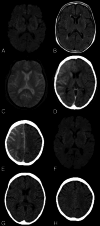False-Negative Motor-Evoked Potential Due to Contrast-Induced Encephalopathy During Coil Embolization for Intracranial Aneurysm: A Case Report
- PMID: 39540192
- PMCID: PMC11560081
- DOI: 10.7759/cureus.73487
False-Negative Motor-Evoked Potential Due to Contrast-Induced Encephalopathy During Coil Embolization for Intracranial Aneurysm: A Case Report
Abstract
Contrast-induced encephalopathy (CIE) is a rare neurological complication that can occur following the use of contrast media during angiographic procedures. It can lead to neurological deficits, such as motor weakness. Transcranial motor-evoked potential (TcMEP) monitoring is commonly used to detect pyramidal tract disorders during embolization for intracranial aneurysms. However, it remains unclear whether TcMEP monitoring is effective in cases of motor weakness associated with CIE. We present a case of a false-negative motor-evoked potential caused by CIE during coil embolization for unruptured internal carotid artery aneurysms. A 68-year-old woman with dizziness underwent an MRI, which revealed multiple unruptured cerebral aneurysms, including a right anterior choroidal artery aneurysm (Ach AAn) and a posterior communicating artery aneurysm (Pcom AAn). Coil embolization was performed for the right Ach AAn and Pcom AAn with intraoperative TcMEP monitoring under general anesthesia. Throughout the procedure, no abnormalities were detected in the TcMEP monitoring. A total of 360 mL of contrast medium was used. After regaining consciousness, the patient experienced left hemiplegia and unilateral spatial neglect. Cerebral angiography revealed no missing branches, including those of the Ach A and Pcom A. MRI showed no acute ischemic or hemorrhagic changes. However, CT revealed CIE. The left hemiplegia and unilateral spatial neglect gradually improved and were completely resolved by postoperative day four. This case suggests that CIE-associated motor weakness may not be detected by intraoperative TcMEP monitoring. Therefore, in patients who develop motor weakness immediately after coil embolization for intracranial aneurysms without changes in TcMEP, brain CT should be performed to exclude CIE.
Keywords: cerebral aneurysm; coil embolization; contrast-induced encephalopathy; false-negative; motor-evoked potential.
Copyright © 2024, Takada et al.
Conflict of interest statement
Human subjects: Consent was obtained or waived by all participants in this study. Conflicts of interest: In compliance with the ICMJE uniform disclosure form, all authors declare the following: Payment/services info: All authors have declared that no financial support was received from any organization for the submitted work. Financial relationships: All authors have declared that they have no financial relationships at present or within the previous three years with any organizations that might have an interest in the submitted work. Other relationships: All authors have declared that there are no other relationships or activities that could appear to have influenced the submitted work.
Figures




References
-
- Usefulness of motor-evoked potential monitoring during coil embolization of anterior choroidal artery aneurysms: technical reports. Hiraishi T, Fukuda M, Oishi M, et al. Neurol Res. 2011;33:360–362. - PubMed
-
- Intraoperative motor-evoked potential monitoring during coil embolization for anterior choroidal artery aneurysms. Ito A, Sato K, Niizuma K, Endo H, Matsumoto Y, Tominaga T. Neuroradiology. 2022;64:1221–1229. - PubMed
-
- Transient contrast encephalopathy after carotid artery stenting. Dangas G, Monsein LH, Laureno R, et al. J Endovasc Ther. 2001;8:111–113. - PubMed
-
- Contrast-induced encephalopathy. Babalova L, Ruzinak R, Ballova J, et al. Bratisl Lek Listy. 2021;122:618–620. - PubMed
Publication types
LinkOut - more resources
Full Text Sources
